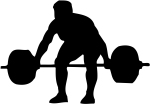- FreeTrainers.com Forums
- Strength & Powerlifting
- Full Squat vs Partial Squat hypertrophy
Group: Strength & Powerlifting
Created: 2012/01/01,
Members: 39,
Messages: 16459
Discuss the topic of Power lifting, Strength training and Strong Man training!
Join group
Full Squat vs Partial Squat hypertrophy

wrestler125
Posts:
4,619
Joined: 2004/01/27  |
2007/01/31, 11:08 PM
Effects of Full Verses Parallel Squats on Quadriceps Muscular Hypertrophy in Healthy Male Athletes
Colker, Carlon M.1; Swain, Melissa A.2; Lynch, Leila2 1Department of Medicine, Greenwich Hospital, Inc. Greenwich, CT, USA. 2Department of Clinical Research, Peak Wellness Foundation, Inc. Greenwich, CT, USA. Introduction: The modern powerlifter utilizes relatively shallow squatting technique to the parallel plane. This is in sharp contrast to the traditional and modern Olympic-style squatting technique of full-depth squats as part of the snatch and the clean and jerk. While alteration of foot direction (i.e., inward vs. outward) has been recently shown to have very little bearing on quad stimulation (Journal of Strength & Conditioning Research 14:379-382,2000), providing a slight heal lift in order to achieve greater depth has long since been repeatedly demonstrated as advantageous for achieving maximum quadriceps stimulation via performance, kinethatic model, force analysis, biomechanical analysis, 3-D cinematography, and electromyographic testing, as beneficial in the way I describe (1-6). Slightly lifting the heal brings the center of gravity away from your lower back and glutes and toward the maximum mass of the quadriceps muscles, thus maximizing direct quad tension. The Soviets have known this for generations and thus were the first to introduce the slight but standard heal-lift built in under every pair of hard Olympic-style weightlifting shoes made to date. This standard of practice affords the squatter a decided technical advantage by allowing the weight lifter to perform a deep squat without compromising proper spine position (7). Our objective was to determine if there is a measurable difference in muscular hypertrophy (quadriceps mass) from performing full squats verses parallel squats in healthy male athletes. Method: Eighteen (18) male athletes between the ages of 18 and 25, of equal size and stature, with no significant quadriceps size difference at baseline (p > 0.05) took part in this prospective, comparative study. Each subject was randomized to one of two (2) groups: parallel squatting (PS) or full squatting (FS), and received guidance in proper modern technique for each respective version. Subjects incorporated their respective techniques in to their regular workout two (2) times each week for six (6) months. Quadriceps mass (defined as a mid-range circumference measurement at the level marked between the center of the patella and the anterior iliac crest) was measured at four (4) time points (baseline, 2, 4, and 6 months). Data was analyzed for inter- and intra- group changes over time). Results: Over the time course of the study and within-group, the PS group experienced only a trend (P = 0.0859) toward quadriceps muscular hypertrophy, while the FS group achieved statistically significant mass gain (P = 0.0073). In terms of between-group differences, the FS group achieved statistically significant greater degree of quadriceps muscular hypertrophy when compared to PS (P = 0.0035). Discussion: Our findings clinically demonstrated that the full squat is superior to the parallel squat for stimulating muscular hypertrophy of the quadriceps. This fact confirms the comparative advantage of the full squat, and applies to amateur, professional, and Olympic athletes alike. References: 1. McLaughlin, T.M., C.J. Dillman, and T.J. Larder. A kinematic model of performance in the parallel squat by champion powerlifters. Med. Sci. Sports. 9:128-133, 1977. 2. McLaughlin, T.M., T.J. Lardner, and C.J. Dillman. Kinetic of the parallel squat. Res. Q. 49:175-189, 1978. 3. Neisell, R., and J. Elkholm. Joint load during the parallel squat in powerlifting and force analysis of in vivo bilateral quadriceps tendon rupture. Scan J. Sports Sci. 8:63-70, 1986. 4. Shapiro, R. Direct linear transformation method for three-dimensional cinematography. Res. Q. 49:197-205, 1978. 5. Stuart, M.J., D.A. Meglan, G.E. Lutz, E.S. Growney, and K.N. An. Comparison of intersegmental tibiofemoral joint forces and muscle activity during various closed kinetic chain exercises. Am. J. Sports Med. 24:792-799, 1996. 6. Wright, G.A., T.H. Delong, and G.Gehlsen. Electromyographic activity of the hamstring during performance of the leg curl, stiff-leg dead lift, and back squat movements. J. Strength Condit. Res. 13:168-174, 1999. 7. Teoriya, I, et al. Biomechanical foundations in the prevention of injuries to the spinal lumbar region during physical exercise training. Soviet Sports Rev. 7:33-40, 1985. ©2002The American College of Sports Medicine -------------- Gravity hates you. Enter the Darkside. |
|
| |

wrestler125
Posts:
4,619
Joined: 2004/01/27  |
2007/01/31, 11:10 PM
This one seems pretty straight up.
While it was a short term study (6 months), some things to take into consideration are that with a parallel squat you can achieve greater posterior chain involvement and lift a greater load in the long run. The hamstrings do not have as much potential for hypertrophy as the quadriceps, and over time, the greater load may lead to greater gains in hypertrophy. However, the take home message is this. Squat Deeper. -------------- Gravity hates you. Enter the Darkside. |

bigandrew
Posts:
5,146
Joined: 2002/10/21  |
2007/02/01, 12:29 AM
But was a study done, squatting deeper with or without the heals being higher?
Woudl squatting that deep, without the raised heel still be as good? -------------- Get your bicep curling, cut off shirt, matching workout outfit wearing,flexing in mirror "toned" wanna-be ass , out of my squat rack! Don't talk to me, only thing that should be moving is the bar. |

wrestler125
Posts:
4,619
Joined: 2004/01/27  |
2007/02/01, 09:58 AM
If you have the flexibility to do it. However, in order to keep the study as standard as possible (IE eliminate technique flaws caused by inflexibility) they raised heals in order to make certain proper depth could be hit.
-------------- Gravity hates you. Enter the Darkside. |

ecle5c
Posts:
1,312
Joined: 2003/07/10  |
2007/02/02, 11:23 AM
Not exactly the purpose of the study, but is this saying that raising your heel (with a weight or whatever) allows you to squat deeper thus being more beneficial?
I thought that a month or so back this was discussed as a myth that didn't stand up? |

wrestler125
Posts:
4,619
Joined: 2004/01/27  |
2007/02/02, 09:24 PM
In many people a lack of flexibility can cause break a break down in form when going deep. The reason they used heeled shoes was to eliminate this problem.
If you can't hit depth without raising your heels, then I suggest you work on it. Alternatively, you could by oly lifting shoes, but even oly lifters squat barefoot and have adequate flexibility to hit depth without a heel. A lot of coaches and strength trainers make excuses by saying their guys don't have the flexibility or have too many other problems to squat deep. Well fix your athletes, its your job. -------------- Gravity hates you. Enter the Darkside. |

elpea120
Posts:
69
Joined: 2006/12/17  |
2007/02/03, 09:07 AM
If i have good flexibility should i squat as far as my flexibility will let me, or until my quads are parallel to the floor, because i could probably go far past parallel.
|

Velasca
Posts:
441
Joined: 2006/10/26  |
2007/02/03, 09:38 AM
============ Quoting from wrestler125: In many people a lack of flexibility can cause break a break down in form when going deep. If you can't hit depth without raising your heels, then I suggest you work on it. ============= I think the above answers your question elpea120..go deep if you want....just be sure you have good form :) |

wrestler125
Posts:
4,619
Joined: 2004/01/27  |
2007/02/04, 04:52 PM
From a mass building perspective, this study shows that your legs will respond better to full squats.
From an athletic training perspective, the muscles most important to athletic performance are hit better the deeper your squat. IMO, squat deeper. ============ Quoting from elpea120: If i have good flexibility should i squat as far as my flexibility will let me, or until my quads are parallel to the floor, because i could probably go far past parallel. ============= -------------- Gravity hates you. Enter the Darkside. |

bigandrew
Posts:
5,146
Joined: 2002/10/21  |
2007/02/06, 11:09 AM
I've now always concidered parallel the minimum depth to hit.-------------- Get your bicep curling, cut off shirt, matching workout outfit wearing,flexing in mirror "toned" wanna-be ass , out of my squat rack! Don't talk to me, only thing that should be moving is the bar. |
